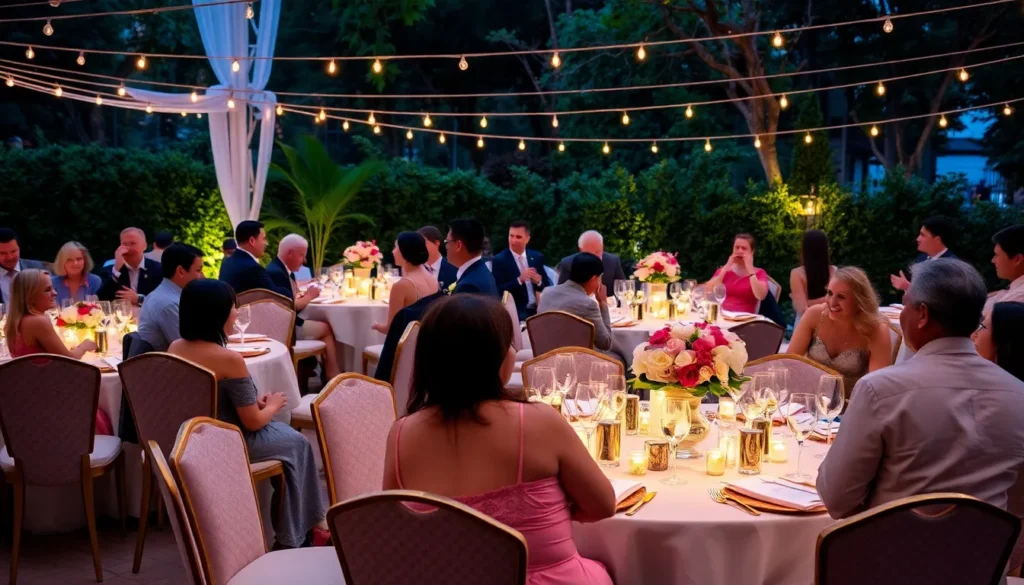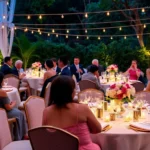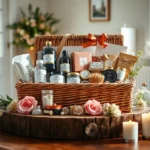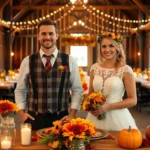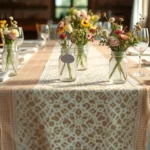Planning your wedding seating arrangement can feel overwhelming but it doesn’t have to be a source of stress. We’ve all been there – staring at a guest list wondering how to create the perfect mix of personalities while keeping everyone happy and comfortable.
The right table plan transforms your reception from a simple dinner into an unforgettable celebration where conversations flow naturally and connections spark. Whether you’re hosting an intimate gathering of 30 or a grand celebration of 300 guests we’ll show you proven strategies that work for every wedding style and budget.
From traditional round tables to creative alternatives like long banquet-style arrangements we’ll explore fresh ideas that’ll make your seating chart both functional and memorable. Ready to turn one of wedding planning’s biggest challenges into an exciting opportunity to bring your loved ones together?
Classic Round Table Arrangements for Elegant Wedding Receptions
Round tables remain the gold standard for wedding receptions because they naturally encourage conversation and create an intimate atmosphere. These timeless arrangements work beautifully for both formal and casual celebrations.
Traditional Circular Seating for Intimate Conversations
Traditional round table seating creates natural conversation circles that make every guest feel included in the discussion. We recommend seating 8 to 10 guests per table to maintain comfortable spacing while encouraging interaction across the entire table.
Strategic guest placement maximizes conversation flow by alternating personalities and backgrounds. Place outgoing guests next to quieter ones to balance the energy, and seat people with common interests near each other. Couples should sit together, but avoid clustering all married pairs on one side of the table.
Table sizing directly impacts the guest experience, with 60-inch tables accommodating 8 people comfortably and 72-inch tables fitting 10 guests without crowding. Smaller tables of 48 inches work perfectly for 6 guests when you want more intimate groupings.
Conversation starters become built into your seating plan when you mix different social circles thoughtfully. We suggest placing one person who knows multiple guests at each table to serve as a natural conversation facilitator.
Family Style Round Tables with Mixed Guest Groups
Family style round table arrangements bring together diverse guest groups to create new connections and strengthen existing relationships. These mixed seating plans work exceptionally well for couples who want their different social circles to mingle naturally.
Generational mixing creates ever-changing table conversations by seating grandparents near young professionals, college friends beside work colleagues, and family members with childhood friends. This approach often leads to unexpected friendships and memorable conversations that guests talk about long after the wedding.
Interest based groupings form when we strategically place guests with shared hobbies, career paths, or life experiences at the same table. Travel enthusiasts bond over destination stories, parents connect through shared experiences, and hobby groups like photographers or musicians naturally find common ground.
Geographic connections emerge when we seat guests from the same hometown, college, or current city together, even if they haven’t met before. These location based connections often spark immediate conversations about shared places and experiences.
Balance considerations ensure each table has a good mix of personalities, ages, and energy levels to prevent any table from feeling too quiet or overwhelming. We typically include at least one couple who knows other guests at each table to help help introductions and keep conversations flowing smoothly.
Long Banquet Tables for Modern Wedding Celebrations
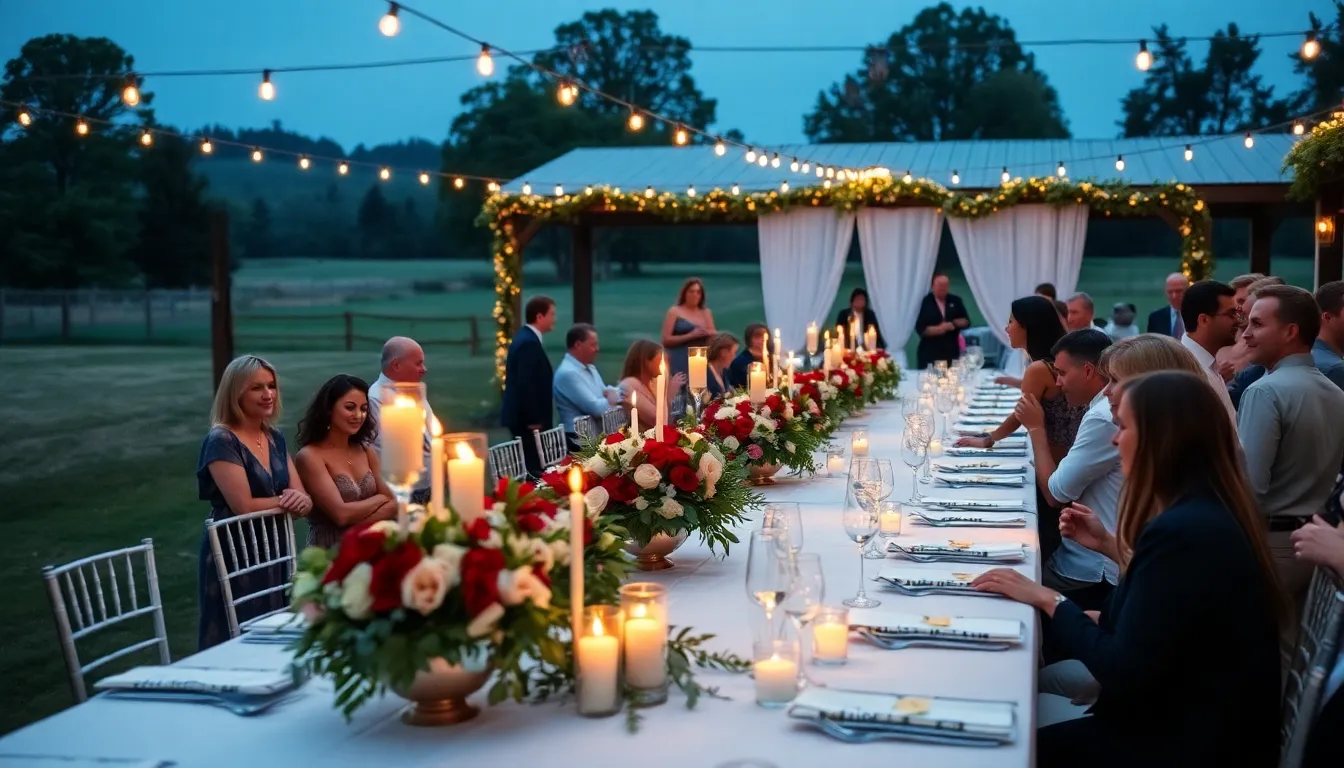
Long banquet tables transform your wedding reception into an elegant communal dining experience that’s both visually stunning and highly functional. These contemporary arrangements encourage natural conversation flow while maximizing your venue space efficiently.
Feasting Tables That Encourage Guest Interaction
Feasting tables create an atmosphere of togetherness that brings guests closer together throughout your celebration. These extended dining arrangements work exceptionally well in rectangular venues, providing clear pathways for movement while maintaining an intimate dining experience. We recommend arranging tables in parallel rows or a distinctive U-shape configuration to optimize guest interaction patterns.
Strategic placement becomes crucial when you’re working with 150 guests, as each 8-foot table accommodates approximately 10 people comfortably. Consider mixing different social circles at each table to spark new conversations and strengthen existing relationships. The communal nature of long tables naturally breaks down barriers between guests who might not otherwise interact.
Visual impact plays a important role in the success of feasting table arrangements. Candlelit garlands or elaborate floral arrangements running down the center create stunning focal points that enhance the overall aesthetic. These centerpiece elements also serve as natural conversation starters, giving guests something beautiful to admire and discuss.
Rustic Farm Tables for Outdoor Wedding Venues
Rustic farm tables bring natural charm and authenticity to outdoor wedding celebrations, perfectly complementing garden or countryside settings. These sturdy wooden tables can be combined to create extended dining arrangements that blend seamlessly with your outdoor environment. Natural wood grain and weathered finishes add character while maintaining the elegant atmosphere you want for your special day.
Outdoor venues benefit from the flexibility that farm tables provide, as they can be arranged in various configurations depending on your industry. Rolling hills, garden pathways, or open fields all work beautifully with this rustic approach. Vintage decor elements like mason jar centerpieces, burlap runners, or lantern lighting enhance the farm table aesthetic while creating warm ambiance as daylight fades.
Weather considerations become important when planning outdoor farm table arrangements. We suggest having backup plans for sudden weather changes, including tent options or covered pavilion areas. Rustic cross-back chairs or elegant dining chairs complement the farm table style while providing comfortable seating for extended celebration periods.
Sweetheart Table Ideas for the Happy Couple
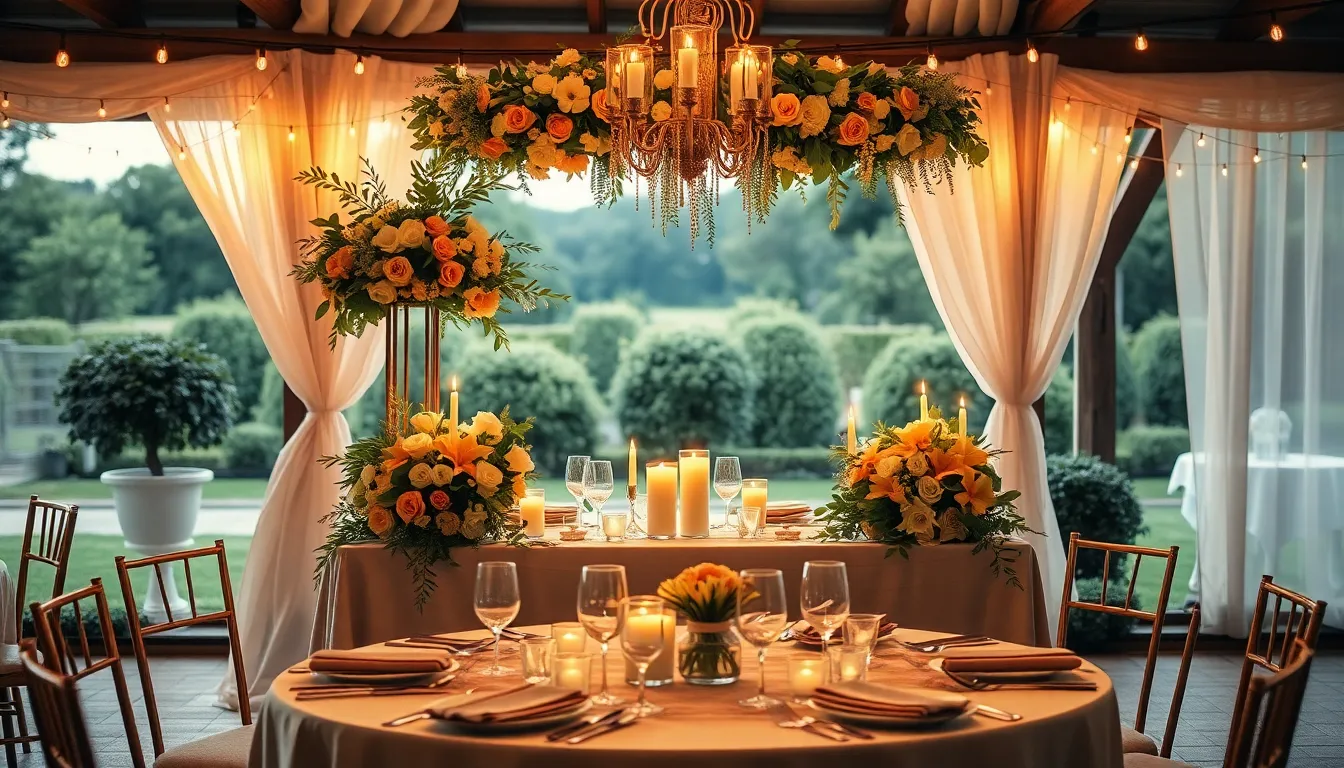
After exploring traditional seating arrangements, we’ll focus on creating intimate spaces specifically designed for the newlyweds. Sweetheart tables offer couples a private moment together while remaining connected to their celebration.
Elevated Head Tables with Romantic Décor
Tiered seating transforms your wedding table into a grand focal point that commands attention. We recommend raising the couple’s table 6 to 12 inches above guest seating to create visual hierarchy and romantic flair. Platform risers, decorative boxes, or built in venue stages work perfectly for this elevated approach.
Romantic lighting sets the mood for your special dining experience. String lights draped behind the table, dimmed overhead chandeliers, or strategically placed candles create warm ambiance that photographs beautifully. We suggest combining multiple light sources like fairy lights with pillar candles for layered illumination.
Floral arrangements add dramatic impact when positioned around elevated tables. Large arrangements placed at the back or sides of your raised table create stunning backdrops without blocking guest views. Consider using tall centerpieces with roses, peonies, or seasonal blooms that complement your wedding colors.
Intimate Two-Person Tables Overlooking Guests
Private yet visible positioning allows couples to enjoy intimate moments while staying connected to their celebration. We recommend placing your sweetheart table at an angle where guests can see you clearly, but you still feel secluded enough for personal conversation. Corner placements or bay window areas work exceptionally well for this setup.
Natural backdrops enhance the romantic atmosphere of two person dining arrangements. Garden views, ocean vistas, or mountain landscapes provide stunning scenery that elevates your dining experience. We suggest positioning your table to take advantage of golden hour lighting or scenic venue features.
Customized tableware adds personal touches that make your sweetheart table uniquely yours. Monogrammed napkins, engraved plates, or custom menu cards create special details that reflect your personality as a couple. Consider incorporating family heirlooms, vintage china, or handwritten place cards for meaningful personalization.
U-Shaped Table Configurations for Inclusive Dining
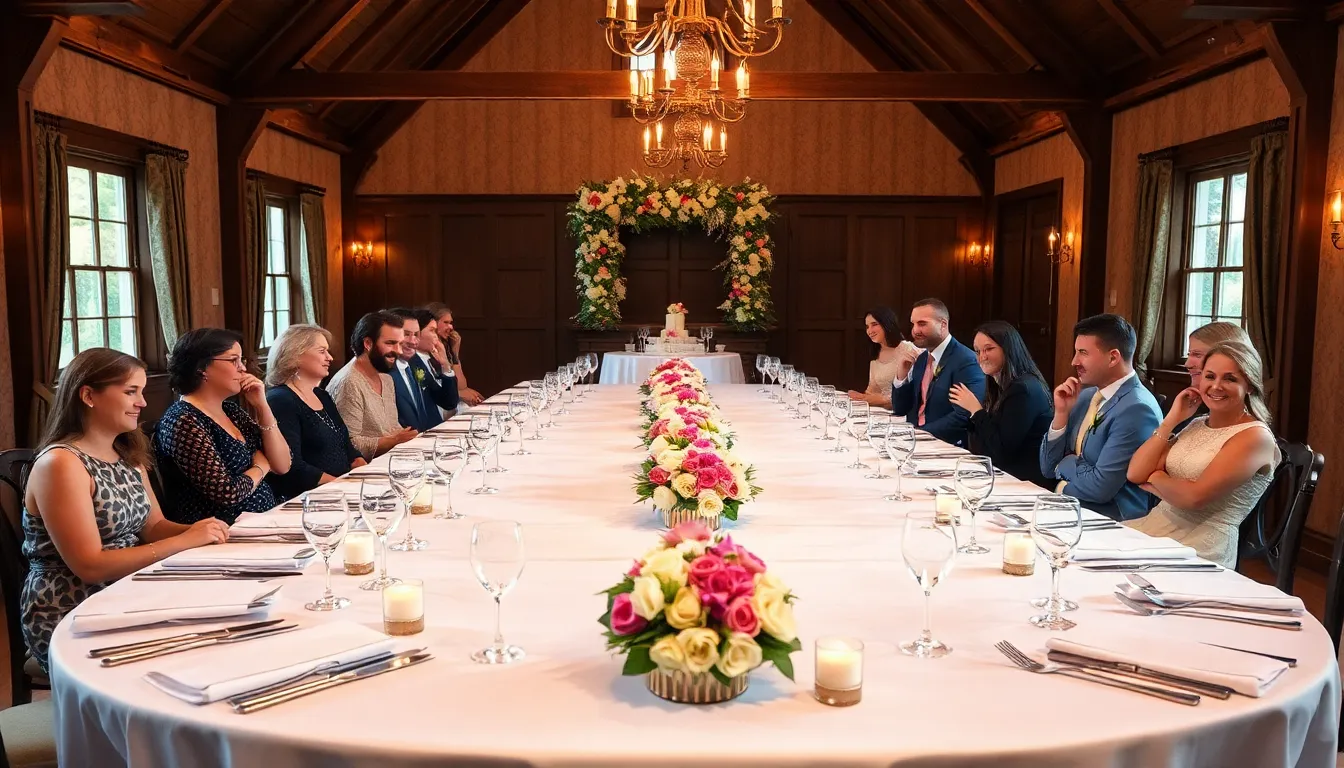
U-shaped table configurations create an intimate and inclusive atmosphere that allows all guests to face each other and participate in conversations. These arrangements work particularly well for couples who want to foster meaningful connections among their wedding guests.
Horseshoe Arrangements That Keep Couples Central
Centralized positioning makes horseshoe table arrangements perfect for highlighting the wedding party while maintaining guest engagement. This configuration places couples or the bridal party at the focal point of the dining area, ensuring they remain visible and accessible to all attendees throughout the reception.
Flexible capacity allows horseshoe shapes to accommodate different guest counts by adding or removing table sections as needed. Wedding planners can easily adjust the configuration to fit venues of various sizes, making this arrangement suitable for both intimate gatherings and larger celebrations.
Enhanced visibility ensures that all guests can see the couple during important moments like speeches and toasts. The curved design eliminates blind spots that often occur with traditional rectangular arrangements, creating better photo opportunities and allowing everyone to feel included in special moments.
Conversation flow improves naturally with horseshoe configurations since guests can easily make eye contact and engage with people across the arrangement. This setup encourages broader social interaction while keeping the focus on the celebrating couple at the center of attention.
Modified U-Shapes for Smaller Wedding Parties
Intimate atmosphere develops when modified U-shapes are used for smaller wedding parties, creating a cozy setting that brings guests closer together. These configurations work exceptionally well for guest lists under 50 people, where maintaining personal connections becomes more manageable and meaningful.
Adaptable sizing allows couples to combine smaller tables or use modular furniture to form customized U-shapes that fit their exact guest count. This flexibility ensures that no guest feels isolated or disconnected from the main celebration, regardless of the venue size or layout constraints.
Inclusive participation becomes effortless when all guests can see and hear each other throughout the reception. Modified U-shapes eliminate the need for multiple separate tables, ensuring that everyone feels like they’re part of one cohesive celebration rather than divided into smaller groups.
Cost efficiency makes modified U-shapes an attractive option for budget-conscious couples since they often require fewer centerpieces and decorative elements. The streamlined design focuses attention on the natural beauty of the arrangement itself, reducing the need for elaborate table decorations while maintaining visual appeal.
Mix-and-Match Table Styles for Unique Wedding Themes
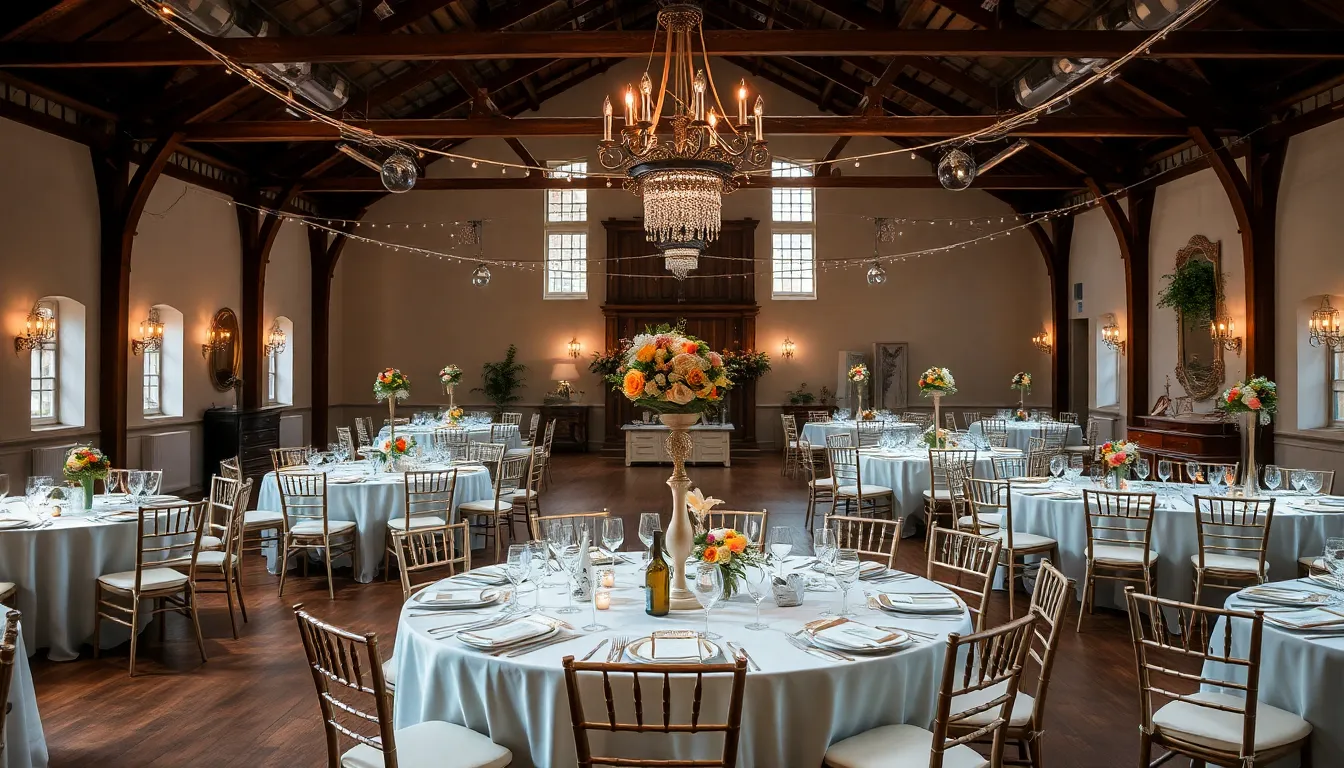
Creating visual variety through strategic table placement transforms your wedding reception into a ever-changing celebration space. We’ve found that combining different table styles adds sophistication while accommodating diverse guest needs.
Combining Round and Rectangular Tables Strategically
Strategic placement of round and rectangular tables creates seamless visual transitions throughout your reception space. Round tables naturally encourage intimate conversations among 8 to 10 guests, while rectangular tables provide spaciousness and sophistication for larger groups.
Ever-changing energy flows when you alternate between table shapes, keeping guests engaged and creating natural conversation zones. We recommend placing round tables near the dance floor for easy movement and positioning rectangular tables along venue walls to maximize seating capacity.
Visual interest increases dramatically when different table styles complement your wedding theme through coordinated centerpieces. Round tables work perfectly with cascading floral arrangements, while rectangular tables showcase long, low centerpieces that don’t obstruct conversation.
Space optimization becomes effortless when rectangular tables fill narrow areas or accommodate wedding parties, while round tables create cozy gathering spots in open spaces. This combination allows you to seat more guests comfortably without sacrificing the intimate atmosphere you desire.
Vintage and Modern Table Combinations
Vintage elegance emerges when you pair ornate centerpieces and antique linens with sleek modern table bases. We suggest incorporating heirloom pieces like vintage china or crystal stemware to create meaningful connections between past and present.
Modern sophistication balances vintage elements through contemporary lighting fixtures and streamlined table runners. Clean lines and metallic accents prevent vintage pieces from overwhelming your overall aesthetic while maintaining visual cohesion.
Eclectic charm develops when mixing vintage wooden farm tables with modern acrylic chairs or combining antique brass candelabras with minimalist place settings. This approach creates conversation starters and reflects couples who appreciate both traditional and contemporary design elements.
Personalized touches shine through unique seating arrangements that combine vintage benches with modern chairs, adding texture and visual depth to your reception layout. Consider using family heirloom pieces alongside rented modern elements to tell your love story through table design.
Family-Style Seating Plans for Close-Knit Celebrations
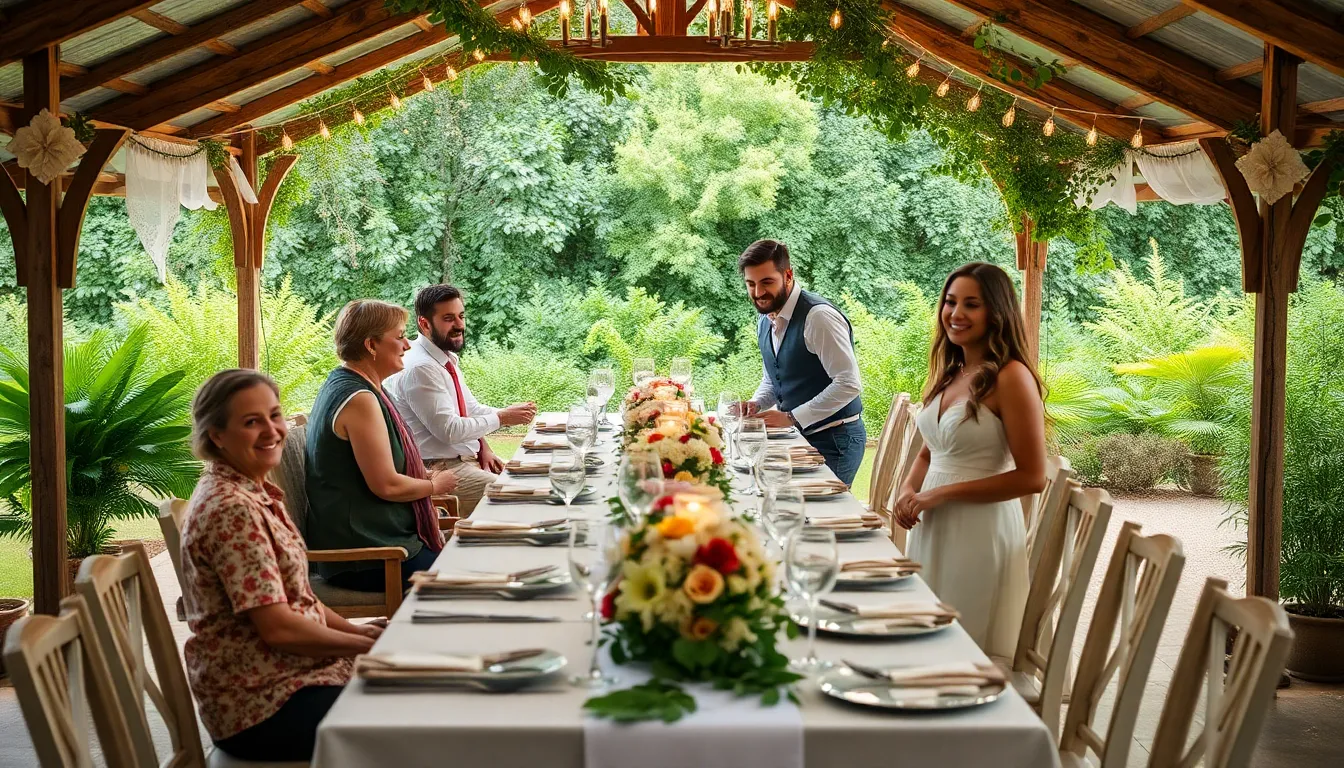
Family style seating transforms your wedding reception into an intimate gathering that strengthens bonds between loved ones. These arrangements prioritize connection over formality, creating an atmosphere where meaningful conversations naturally flourish.
Large Communal Tables for Extended Family Groups
Long rectangular tables accommodate larger family groups while promoting a sense of community and shared experience throughout your celebration. We recommend using these extended arrangements when you want to keep extended family units together, ensuring comfort and encouraging natural bonding during the reception.
Central placement strategies work best when you position key family members at the center of these long tables. This configuration facilitates conversation flow and ensures that influential family members can easily interact with everyone seated along the table’s length.
Community dining benefits include the ability to serve family style meals that encourage sharing and conversation. These arrangements create opportunities for relatives who rarely see each other to reconnect and form new memories together.
Space optimization becomes easier with long tables since they can accommodate 12 to 16 guests per table compared to traditional round tables. This efficiency allows you to seat more people in smaller venues while maintaining the intimate family atmosphere you desire.
Kids’ Tables with Special Entertainment Considerations
Designated children’s areas require strategic placement near adult supervision while providing enough space for activities and movement. We suggest positioning kids’ tables within sight of parents but far enough away to prevent disruption during speeches or formal moments.
Entertainment essentials should include puzzles, coloring books, and age appropriate games that keep children engaged throughout the reception. Activity boxes customized to different age groups ensure that both toddlers and tweens remain entertained during longer celebration periods.
Supervision arrangements work best when you assign exact adults to monitor the children’s table rotation. This approach ensures safety while allowing parents to enjoy the celebration, knowing their children are well cared for and engaged.
Special dietary considerations become crucial when planning kids’ tables since children often have different preferences and restrictions than adults. We recommend coordinating with your caterer to provide child friendly meal options that accommodate common allergies and preferences.
Cocktail-Style High Table Arrangements for Casual Weddings

Modern couples increasingly choose cocktail-style receptions for their relaxed atmosphere and enhanced guest interaction. These elevated arrangements break away from traditional formal dining while maintaining elegance and sophistication.
Standing Reception Tables with Bar Stools
Standing reception tables create ever-changing energy that keeps guests engaged throughout the celebration. Bar stools provide comfortable elevated seating at 42-inch high tables, allowing guests to easily transition between sitting and standing positions during conversations.
Elevated seating offers several advantages for wedding receptions:
- Guests maintain eye contact more naturally during conversations
- Movement between tables happens effortlessly
- Photography becomes more ever-changing with varied heights
- Space utilization improves dramatically compared to traditional setups
Flexible seating arrangements accommodate different guest preferences and physical needs. We recommend providing a mix of fully standing tables and those with bar stools to create options for everyone. This setup allows easy rearrangement throughout the evening, especially when transitioning from dinner service to dancing.
Consider spacing high tables 6-8 feet apart to allow comfortable movement between them. Each table typically accommodates 4-6 guests comfortably, promoting intimate conversations while maintaining the overall social atmosphere.
Mix of High and Low Tables for Varied Preferences
Mixed height arrangements cater to diverse guest needs while creating visual interest throughout the reception space. This approach combines 30-inch standard tables with 42-inch cocktail tables, offering multiple seating experiences within the same venue.
Tiered seating enhances the overall guest experience by providing choice and comfort. Older relatives often prefer traditional seated arrangements, while younger guests enjoy the social energy of standing tables. We suggest allocating 60% high tables and 40% standard height tables for optimal balance.
Flexible layouts accommodate both seated meals and standing social events seamlessly. Consider these strategic placements:
- Position low tables near the dance floor for easy access
- Arrange high tables around the perimeter for conversation zones
- Create transition areas between different table heights
- Designate exact areas for elderly guests who prefer seated arrangements
This mixed approach allows couples to serve both plated dinners and cocktail-style appetizers, adapting to different reception timeline preferences. The variety keeps guests engaged while ensuring everyone finds their comfort zone throughout the celebration.
Outdoor Wedding Table Plan Ideas for Garden Ceremonies
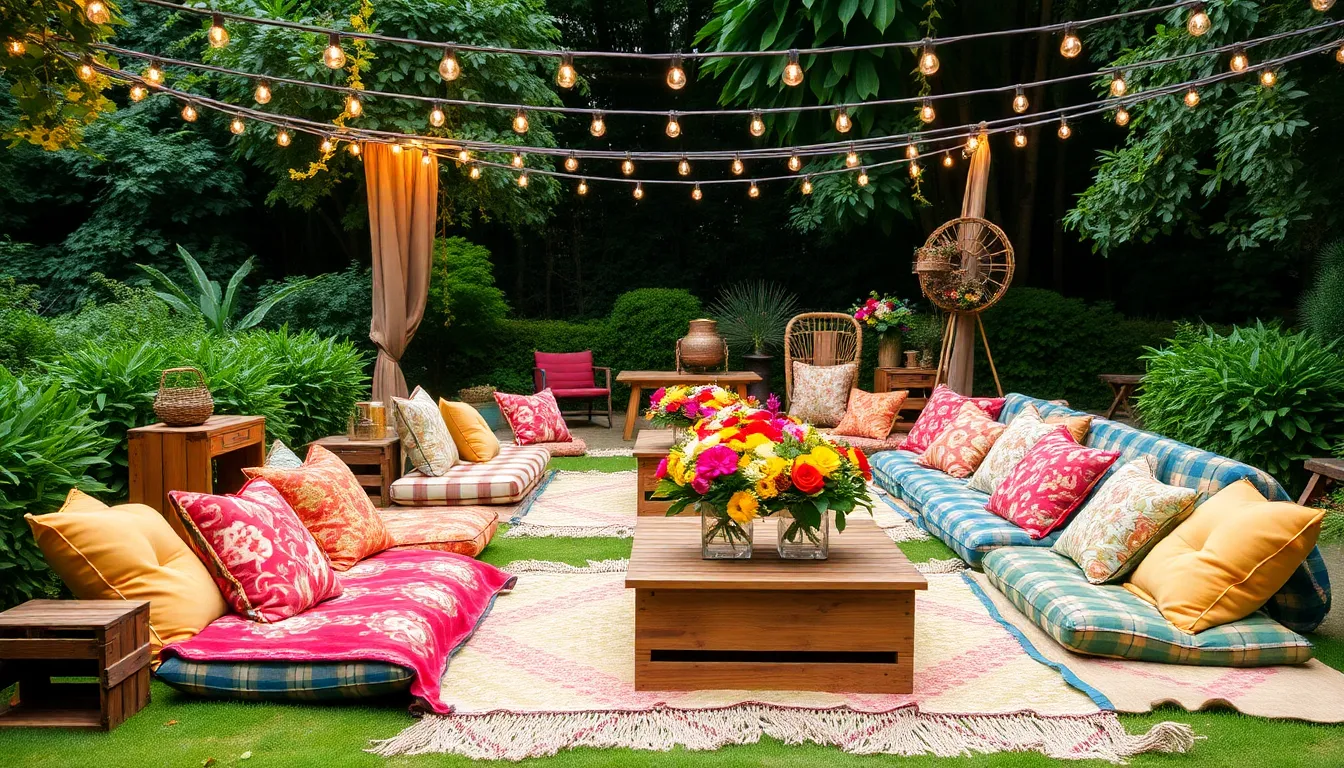
Garden ceremonies offer unique opportunities to create memorable outdoor dining experiences that blend natural beauty with thoughtful table arrangements.
Picnic-Style Arrangements for Casual Outdoor Weddings
Blanket and cushion seating with picnic baskets creates an intimate, cozy atmosphere perfect for relaxed outdoor celebrations. We recommend arranging colorful blankets in clusters across your garden space, adding plush cushions and low tables for comfortable dining. Picnic baskets filled with snacks, drinks, and wedding favors serve as both functional dining accessories and charming decor elements that guests can take home as mementos.
Shaded picnic areas ensure guest comfort throughout your ceremony and reception. Strategic placement of umbrellas, canopies, or natural shade from trees creates comfortable dining zones that protect guests from sun exposure. Consider positioning these shaded areas near garden pathways to maintain easy access while preserving the natural flow of your outdoor space.
Natural ground coverings like vintage quilts or woven rugs add texture and warmth to your picnic style setup. Mix different patterns and colors to create visual interest while maintaining a cohesive outdoor aesthetic. Low wooden crates or tree stumps can serve as additional seating options that complement the rustic garden theme.
Elegant Outdoor Dining Under String Lights
String light canopies transform outdoor dining areas into romantic, enchanting spaces perfect for evening celebrations. We suggest creating overhead lighting networks that span across multiple tables, forming an illuminated ceiling that adds magical ambiance to your garden ceremony. Edison bulb string lights or fairy lights work particularly well for creating this dreamy atmosphere.
Garden centerpieces featuring vibrant flower arrangements and terrariums enhance your dining tables while maintaining the outdoor theme. Fresh blooms from your garden ceremony site, combined with greenery and natural elements like moss or stones, create stunning focal points. Consider incorporating herbs like lavender or rosemary that add fragrance and can double as wedding favors for guests.
Elevated table arrangements on wooden platforms or garden decking create distinct dining zones within your outdoor space. This approach allows you to incorporate different lighting levels while maintaining clear sightlines for your guests. Combine tall and short arrangements to add visual depth and accommodate various guest preferences for intimate or communal dining experiences.
Cultural Wedding Table Traditions and Modern Adaptations
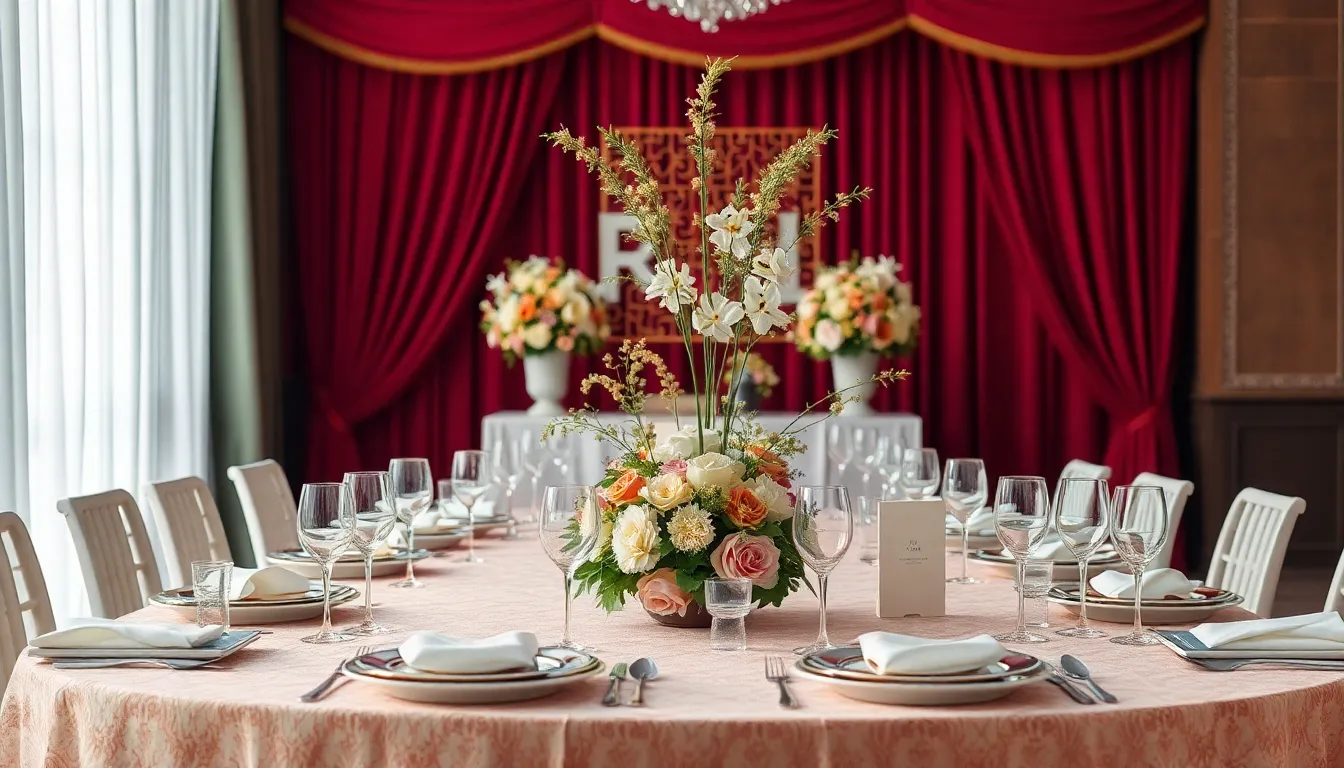
Cultural traditions bring profound meaning to wedding table plans while modern adaptations allow couples to honor their heritage in fresh, contemporary ways.
Traditional Ethnic Seating Arrangements
Asian cultural seating follows hierarchical principles that reflect family status and generational respect. We arrange elderly relatives and honored guests closest to the couple’s table, while younger family members sit at tables positioned further away. This time-honored system creates a visual representation of family structure and ensures proper acknowledgment of important relationships.
African cultural traditions emphasize community and inclusivity through their seating arrangements. Tables are positioned to encourage interaction between different family groups, fostering connections that extend beyond the wedding day. We often see circular formations that symbolize unity, with no clear beginning or end to represent the eternal nature of family bonds.
Middle Eastern customs typically separate men and women into distinct seating areas, though modern interpretations often create mixed arrangements while still honoring traditional elements. Family patriarchs and matriarchs receive places of honor, and we frequently incorporate traditional textiles and decorative elements that reflect the family’s cultural heritage.
Latin American traditions focus on extended family connections, with godparents (padrinos) receiving prominent seating positions. We arrange tables to accommodate large family groups while ensuring that key sponsors and mentors are properly recognized throughout the celebration.
Blending Cultural Elements with Contemporary Styles
Modern materials can showcase traditional motifs through updated interpretations. We incorporate cultural patterns into contemporary table runners, use family heirlooms as centerpieces alongside modern floral arrangements, and blend traditional color palettes with current design trends. This approach creates sophisticated table settings that honor the past while embracing present-day aesthetics.
Themed integration allows couples to tell their cultural story through creative table concepts. Travel destination themes work particularly well when couples represent different cultural backgrounds, with each table featuring elements from important locations in their heritage. We’ve seen successful implementations where couples use family tree concepts, displaying ancestry through carefully curated table decor and meaningful photographs.
Fusion celebrations combine multiple cultural traditions into cohesive table plans. Mixed heritage couples often create unique arrangements where one side of the reception reflects one culture while the other showcases different traditions. We recommend using common elements like flowers or lighting to create visual unity while allowing each cultural influence to shine through distinct decorative choices.
Contemporary adaptations of traditional seating can include digital elements like QR codes linking to family stories, modern interpretations of cultural symbols, and updated versions of ceremonial table settings. These approaches maintain cultural significance while appealing to guests who appreciate both tradition and innovation.
Strategic Guest Placement Tips for Harmonious Table Plans
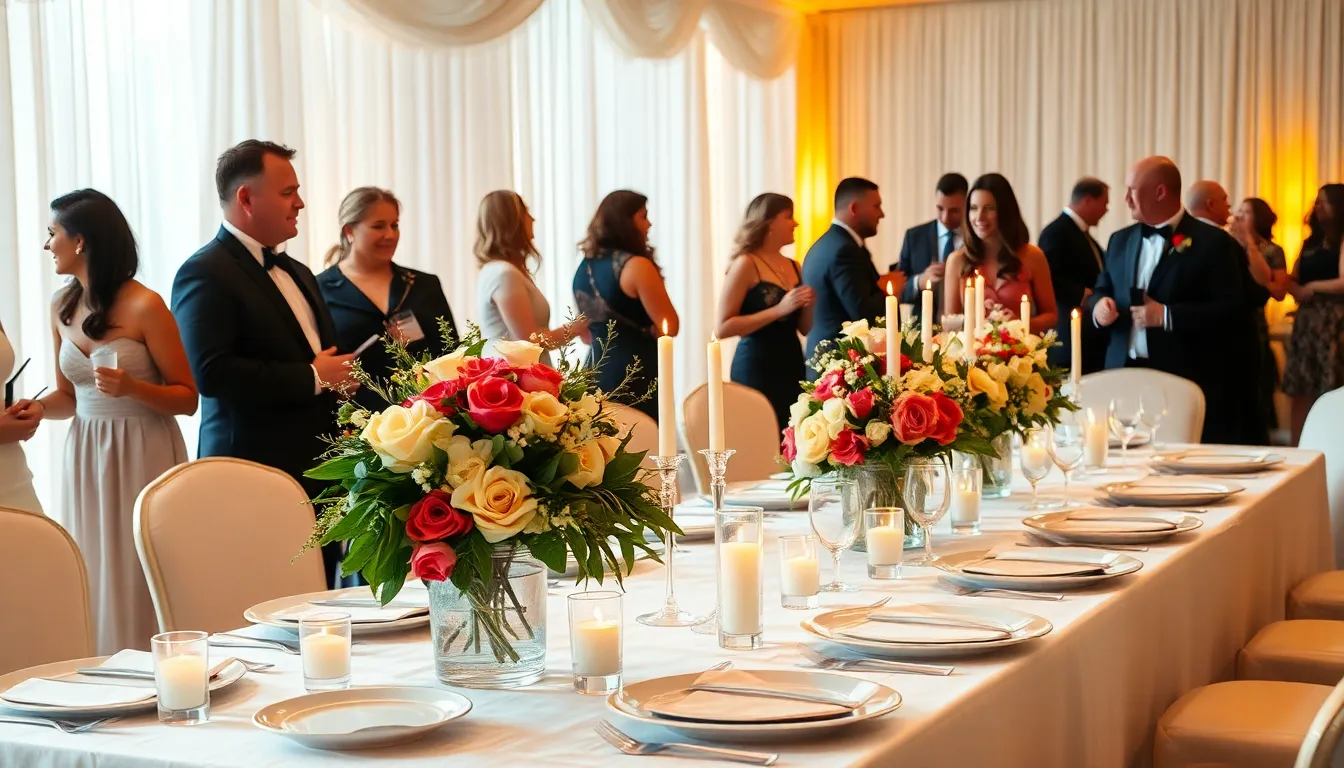
Thoughtful guest placement transforms your wedding reception from a simple dinner into a memorable celebration where everyone feels connected. We’ll guide you through proven strategies that create natural conversation flow and ensure every guest enjoys meaningful interactions throughout your special day.
Balancing Personalities and Relationships
Mixing personality types creates ever-changing table conversations that keep guests engaged throughout the evening. We recommend pairing introverts with extroverts at each table to encourage natural dialogue and prevent awkward silences. Outgoing guests naturally draw quieter individuals into conversations while benefiting from their thoughtful perspectives.
Group guests by shared interests rather than just relationship categories to spark meaningful connections. Place guests who enjoy similar hobbies like hiking, cooking, or photography together to create instant conversation starters. Travel enthusiasts bond over destination stories while book lovers discuss their latest reads.
Consider relationship dynamics when organizing your seating arrangements to avoid potential conflicts. Keep divorced family members at separate tables while ensuring they both feel equally honored in your celebration. Former colleagues who had workplace disagreements need strategic placement to maintain harmony.
Balance age groups strategically to create intergenerational connections that enrich your celebration. We suggest placing one or two younger guests at tables with older relatives to bridge generational gaps naturally. Grandparents often enjoy sharing stories with your college friends while younger guests appreciate wisdom from experienced family members.
Creating Conversation Friendly Table Assignments
Use themed table assignments to give guests natural talking points and shared experiences to discuss. Name tables after destinations you’ve visited together like “Paris” or “Costa Rica” to inspire travel stories. Food themed tables such as “Pasta Lovers” or “Taco Tuesday” create immediate connections among guests with similar culinary preferences.
Create interactive seating displays that encourage guests to mingle while finding their assigned spots. Design artistic seating charts using mirrors, vintage frames, or hand drawn illustrations that guests can admire and photograph. Place name cards with fun facts about each guest to serve as conversation ice breakers at their tables.
Provide conversation starter cards at each place setting to help shy guests initiate discussions naturally. Include questions about favorite memories with the couple or interesting personal achievements. These prompts work especially well for tables mixing different friend groups or family branches.
Position special accommodations thoughtfully to ensure elderly or disabled guests feel included while accessing necessary support. Place mobility challenged relatives near accessible entrances and restrooms without isolating them from family conversations. Reserve front row tables for hearing impaired guests so they can easily follow speeches and toasts.
Organize family style arrangements that encourage sharing and create communal dining experiences. Long rectangular tables accommodate larger family groups while promoting the sense of community your celebration deserves. Central placement of key family members facilitates natural conversation flow throughout the meal service.
Conclusion
With these diverse wedding table plan ideas at your disposal you’re well-equipped to create a seating arrangement that reflects your unique style and ensures your guests have an unforgettable experience. Whether you choose classic round tables intimate sweetheart setups or innovative outdoor arrangements the key lies in thoughtful planning that considers your guests’ personalities and relationships.
Remember that the perfect table plan balances aesthetic appeal with practical functionality. From cultural traditions to modern mix-and-match styles there’s no single right approach – only what works best for your celebration.
Trust your instincts consider your venue’s layout and don’t hesitate to blend different concepts to create something uniquely yours. Your wedding table plan should tell your love story while bringing your favorite people together in the most meaningful way possible.
Frequently Asked Questions
How many guests should I seat at each round table?
The ideal number is 8 to 10 guests per round table. This size promotes intimate conversation while ensuring everyone can easily interact with each other. Tables with fewer than 8 guests may feel empty, while more than 10 can make conversation difficult across the table and create an overcrowded feeling.
What are the benefits of long banquet tables versus round tables?
Long banquet tables create a modern, communal dining experience that encourages natural conversation flow and maximizes venue space. They work especially well for larger gatherings and can be arranged in parallel rows or U-shapes. Round tables, however, are better for intimate conversations and are considered the classic gold standard for wedding receptions.
Should we have a sweetheart table or sit with our wedding party?
A sweetheart table gives you and your partner private moments while staying connected to your celebration. Consider elevating your table for visual hierarchy and romantic flair. If you prefer more interaction, sitting with your wedding party can create a livelier atmosphere, but you’ll have less intimate time together during dinner.
How do I strategically place guests to encourage good conversations?
Balance personalities by pairing introverts with extroverts, group guests by shared interests or hobbies, and consider relationship dynamics to avoid conflicts. Mix different age groups and backgrounds to foster new connections. Use themed table assignments and avoid seating guests who have known conflicts together.
What outdoor table arrangements work best for garden weddings?
Picnic-style arrangements with blankets, cushions, and picnic baskets create cozy, intimate atmospheres. Ensure shaded areas for guest comfort and use natural ground coverings. String lights add romantic ambiance for evening celebrations, while elevated table arrangements help define distinct dining zones in outdoor spaces.
How can I incorporate cultural traditions into my seating plan?
Research your heritage’s traditional seating arrangements and adapt them for modern venues. Consider family hierarchy, community values, and cultural significance when placing guests. You can blend multiple cultural elements for fusion celebrations or use contemporary adaptations that maintain cultural significance while appealing to diverse guest lists.
Where should I place the kids’ table?
Position kids’ tables near adult supervision, preferably close to parents or trusted family members. Provide entertainment essentials like coloring books, small games, or tablets. Consider special dietary needs and ensure the location is easily accessible for parents while keeping children engaged and comfortable throughout the reception.
What’s the advantage of mix-and-match table styles?
Combining different table shapes creates visual variety and sophistication while optimizing space usage. Strategic placement of round and rectangular tables can enhance guest engagement by creating natural conversation zones. This approach allows you to accommodate different group sizes while adding aesthetic interest to your reception layout.
How do U-shaped table configurations work for weddings?
U-shaped arrangements create intimate, inclusive atmospheres where all guests can face each other and engage in conversations. They keep the couple central and visible to all attendees while enhancing conversation flow. These configurations are flexible and work well for both intimate gatherings and larger celebrations.
What backup plans should I have for outdoor wedding seating?
Always have indoor alternatives or covered areas in case of inclement weather. Consider tent rentals, ensure pathways remain accessible, and have protective coverings for decorative elements. Plan for temperature changes with heating or cooling options, and ensure electrical access for lighting and entertainment needs.

